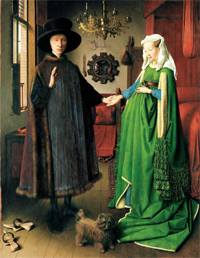By Louis A. Zona
One of the greatest works of art in history was painted in 1434 by Jan van Eyck, a Flemish painter often credited with inventing the medium of oil paint.
The painting depicts the wedding of Giovanni Arnolfini, a wealthy businessman. The painting is filled with elements that tell us much about this wedding and the character of the subjects.
In the painting we see, for example, a small dog at his bride’s feet. The presence of the dog represents faithfulness or fidelity. The pair of slippers signifies respect and the oranges on the windowsill represent wealth. Why would oranges signify wealth? To afford oranges in northern Europe in the dead of winter required wealth because of the rarity of tropical fruit in that time and place.

Art historians refer to this detective work as iconography, which improves our appreciation of the art that we’re observing.
In the Butler Institute’s collection is an American treasure and one of the earliest depictions of Santa Claus. The painting is called “The Night Before Christmas” and Robert Weirs painted it in the 1830s.
Weir was a member of the Knickerbocker Society (that’s where the New York Knicks moniker came from). The Knickerbocker Society was a private men’s club.
A friend of the artist asked Weir if he could paint the Jolly Old Elf described in the poem by the British poet Clement Moore titled “The Night Before Christmas.”
The Butler painting shows an elf-sized Santa about ready to shoot up the chimney after having delivered his gifts. Santa is shown placing his finger on the side of his nose and, according to the poem, “up the chimney he rose.”
This much-heralded painting in Youngstown is filled with fascinating iconography including a broken pipe on the floor. The pipe refers to the initiation rite of the Knickerbockers as does the lemon half that the new members would suck on as part of their entry rituals. Subtly placed above the fireplace appears a shield that happens to be that of the Knickerbockers.
I would add that the current image of Santa as a jolly large man first appeared in the 1920s as part of a Coca-Cola ad campaign. This coming Christmas, check out Santa’s costume when you see him in the mall. It’s Coca-Cola red!
I find this type of research fascinating and reminiscent of the investigations Lt. Columbo conducted. Peter Falk was the disheveled but sharp detective in that long running television show. Columbo looked and acted totally unsophisticated. But if he caught the slightest incongruities in the answers provided by crime suspects, he’d pursue those bad guys until he had them in handcuffs.
And while I’m not equating criminal detective work with the discovery of clues in a work of art, it sure would be satisfying to uncover the real meaning of that smile on Mona Lisa’s face.
If you’re of the age to remember when the Beatles were churning out one hit album after another, you might remember when the brilliant John Lennon had all of us fans trying to figure out if it really was true that Paul McCartney had died.
In their famous “Abbey Road” album, which shows the Fab Four walking in a straight line across the road outside of their studio in London, three Beatles had their shoes on and only Paul was barefoot.
Worldwide concern spread rapidly. Was picturing Paul without shoes referring to a burial rite in which the deceased were buried without shoes?
The next clue could be found by listening very closely to the fading music and lyrics at the quiet conclusion of the album. The words “who killed Paul” seem to come through. At the time of the album’s release, I was teaching high school. The students went absolutely crazy trying to figure out the truth.
And of course we never learned if a hoax had been perpetrated, possibly by John, or whether this was a case of fans overthinking or simply worrying that something bad had happened to everybody’s favorite Beatle.
You probably figured out that in my world all roads lead to art or baseball. But I’m going to throw you a curve and share a boxing tale.
Some years ago when our own Ray “Boom Boom” Mancini was champ, we decided to schedule one of his fights on the big screen at The Butler.
It was an exciting evening. I was seated beside an old-time boxing trainer who had worked with several champions over the years. After watching the first or second round of the fight, I turned to him and said, “Gee, Ray is doing great.”
His reply: “Ray has lost this fight.”
I thought to myself, this guy must not be watching the same fight, Ray’s doing great!
Well guess what. Ray did lose that fight.
Afterward, I asked that trainer how he knew that the fight was lost so early. He just smiled at me as if to say it took me years to know what to look for. To this day, I think about that trainer and wonder what he saw to be able to predict a winner with seemingly so little to go on.
I guess there’s an iconography to be studied in art, as well as boxing and even the Beatles.
